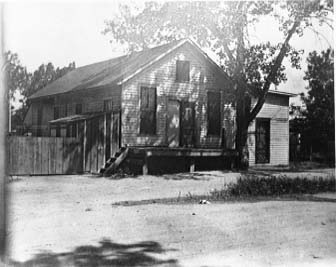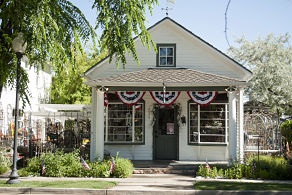Littleton Creamery
Designation—None

Littleton Creamery, c.1903.
The Littleton Creamery, located at 2675 West Alamo, was the center of the community's dairy industry. Built in 1884, farmers would bring their milk to be processed and shipped to Denver as either cream or butter. By 1888 the creamery processed milk from about 1,000 cows. By 1900 the building was used for high school classes until a high school was opened in 1904.t
The vernacular agricultural industry building is a frame structure with wood clapboards. The single story building has a gabled roof. The original creamery had shed additions that have since been lost. In the front gable a small window remains.

Littleton Creamery, 2015. Photo by Amelia Martinez.
This is a building, while still historic, has been altered and it is easy to see when historic and contemporary photos are compared. The hipped roof porch with classical tapered column supports was likely added when the building was converted into a Christian Scientist Church. The bay windows are also latter additions. In 1955 the first Southern Baptist Church owned the building until it was vacated a few years later. The building has had a variety of uses and currently it is an antique store.
More historic photos »
Bibliography
Front Range Research Associates, 1997 Inventory, Littleton Historic Buildings, Inventory Record for the Littleton Creamery, Colorado Cultural Resource Survey Inventory Form 5AH185.
Inventory Sources:
Arapahoe County Assessors Records
Littleton Museum Files
Littleton Independent, October 25, 1963
Littleton Independent Anniversary Issue, 1968
"Littleton Yesterday, Today, and Tomorrow" (Littleton: Littleton Time: July 1990), page 6
Sanborn Fire Insurance Maps, 1893-1949
Littleton City Directories, 1932-1961
Arapahoe Independent, June 27, 1978
Photographs courtesy of the Littleton Museum unless otherwise noted. To order copies, contact the museum at 303-795-3950.
Compiled by Kris Christensen, Colorado Digitization Project
Updated March 2021 by Phyllis Larison